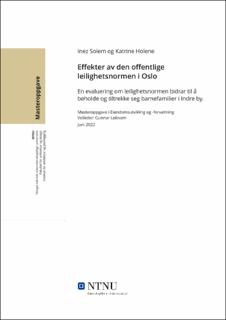| dc.contributor.advisor | Leikvam, Gunnar | |
| dc.contributor.author | Holene, Katrine | |
| dc.contributor.author | Solem, Inez | |
| dc.date.accessioned | 2023-10-02T17:22:55Z | |
| dc.date.available | 2023-10-02T17:22:55Z | |
| dc.date.issued | 2022 | |
| dc.identifier | no.ntnu:inspera:116084088:64885349 | |
| dc.identifier.uri | https://hdl.handle.net/11250/3093568 | |
| dc.description.abstract | Det har lenge vært benyttet en kommunal fortettingsstrategi i arbeidet med by- og stedsutvikling i Oslo. Fortettingsstrategien bidrar til høyere arealutnyttelse som skal redusere transportbehovet og derav klimagassutslipp på sikt. Strategien har ført til en mindre variert boligsammensetning i sentrum, og har på mange måter fungert mot sin hensikt. Som et resultat av dette ble det i 2007 vedtatt en leilighetsnorm i Oslo som regulerer leilighetsfordelingen i nye boligprosjekt i sentrumsnære bydeler. Normen ble etablert for å sikre en mer variert befolkningssammensetning, og har fokusert spesielt på å legge til rette for å beholde barnefamilier i Indre by. Til tross for at normen ble justert i 2013, er det likevel stor uenighet i bransjen om denne har gitt ønskede effekter. Leilighetsnormen bør derfor vurderes med jevne mellomrom, herunder om normen fungerer etter sin hensikt, og om virkeområdet er dekkende.
Tidligere diskusjoner, evalueringer og rapporter har i større grad fokusert på overordnet utvikling av boligbygging og demografi i Oslo. Formålet med denne oppgaven er først og fremst å gi et bidrag til diskusjonen om leilighetsnormens relevans. Den vil videre se på om det er forhold knyttet til boligens størrelse som har betydning, eller om det er andre effekter slik som boligens kvaliteter, bo- og flyttepreferanser og/eller nærområdet. Oppgaven kan dermed bidra til å belyse effekten av direkte reguleringer i kontrast til andre mulige tiltak for å skape en mer variert befolkningssammensetning. Dette resulterte i følgende problemstilling:
«Hva er effekter av den offentlige leilighetsnormen i sentrale bydeler i Oslo?»
For å besvare problemstillingen er det videre formulert tre forskningsspørsmål. Sammen med problemstillingen skal disse belyses gjennom en kvalitativ tilnærming. Datainnsamlingen har blitt gjennomført ved litteraturstudie og dokumentanalyser samt supplering av åpne, individuelle intervju med aktører i bransjen. Funnene våre indikerer at normen ikke oppnår sin hensikt alene, og at den er lite forenlig med barnefamiliers økonomi og ønsker. | |
| dc.description.abstract | A compact-city policy has been used for a long time in the work with urban planning in Oslo. The compact-city policy contributes to better utilization of land which will reduce the need for transport and hence greenhouse gas emission in the long run. The policy has led to less variety in housing types in the City Centre and has in many ways worked against its purpose. As a result, an apartment distribution norm was adopted in 2007 in Oslo.
The apartment distribution norm prohibits the construction of small apartments in districts in and around the City Centre. The purpose was to ensure a more varied population composition and has focused in particular on attracting and keeping families with children in the Inner City. Despite the fact that the norm was adjusted in 2013, there is still great disagreement in the industry as to whether this has led to the desired effects. The norm should be assessed at regular intervals, including whether the norm works as intended and if the scope is adequate.
Previous discussions, evaluations and reports have to a greater extent focused on the overall development of housing construction and demography in Oslo. The purpose of this thesis is to make a contribution to the discussion about the relevance of the apartment distribution norm. It will also examine if there are factors related to the size of the home that are important, or if there are other factors such as housing quality, living and moving criteria and/or the surrounding area. The thesis can therefore contribute to shed light on the effect of direct regulations on contrast to other possible measures to create a more varied population composition. This resulted in the following problem statement:
“What are the effects of the public apartment distribution norm in central districts in Oslo”
Three research questions have been formulated to answer the problem statement. Together with the problem statement, these will be elucidated through a qualitative approach. The data collection has been carried out through a literature study, document analysis and open, individual interviews with key players in the real estate industry. Our findings indicate that the norm does not achieve its purpose alone, and that it is not compatible with family’s economy and preferences. | |
| dc.language | nob | |
| dc.publisher | NTNU | |
| dc.title | Effekter av den offentlige leilighetsnormen i Oslo | |
| dc.type | Master thesis | |
